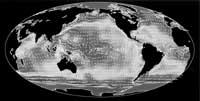Marine currents, argon and climate

U.S. researchers have prepared a technique with a high capacity to detect water argon, changing a particle accelerator to detect and quantify argon atoms. The apparatus detects an argon-39 radioactive isotope and is able to separate a single 39 argon atom from 10,000 atoms. It is intended to use the technique to analyze marine currents and their evolution, as well as the climate. In fact, Argon 39 forms in the atmosphere when cosmic rays touch the normal argon and dissolves rapidly in water.
By losing radioactivity at constant speed, measuring the amount of argon 39 in the water at different depths, you can know when the latter remained on the surface. So far a work of thousands of liters of water and months was needed to measure day 39 of argon in the water, but with the new technique it is estimated that 10 liters of water will be enough and a few hours. However, they do not know if the bright 39 is generated at constant speed and if not, it would not be a reliable indicator.
Buletina
Bidali zure helbide elektronikoa eta jaso asteroko buletina zure sarrera-ontzian











